Tires
For safe operation of your vehicle, it is important that the tires be the correct type and size, in good condition, and properly inflated. Be sure to follow the requirements and recommendations in this section.
Tire Sidewall Labeling
Useful information about a tire is molded into its sidewall. The example below shows a typical passenger car tire.
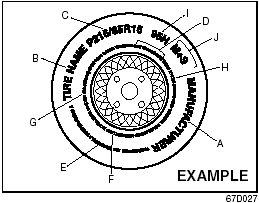
Typical Passenger Car Tire Sidewall
A. Tire Manufacturer.
The name of the tire manufacturer is shown here.
B. Tire Name/Model.
The tire name or model is shown here.
C. Tire Size.
The tire size code is a combination of letters and numbers used to define a particular tire’s width, height, aspect ratio, construction type, and service description. See the “Tire Size” explanation later in this section for more details.
D. U.S. DOT Tire Identification Number.
The Department of Transportation (DOT) marking indicates that the tire is in compliance with the U.S. Department of Transportation Motor Vehicle Safety Standards. The letters and numbers following the DOT marking is the Tire Identification Number (TIN). The TIN identifies the tire manufacturer and plant, tire size, and date the tire was manufactured.
E. Uniform Tire Quality Grading (UTQG).
Tire manufacturers are required to grade tires based on three performance factors: treadwear, traction and temperature resistance. Refer to the “Uniform Tire Quality Grading” section for more details.
F. Load Rating.
Load rating is the maximum weight a tire is designed to support in normal service.
G. Max Inflation Pressure.
Max inflation pressure is the maximum inflation pressure a tire is designed for.
H. Tire Ply Material.
These tire markings describe the type of cord and number of plies in the sidewall and under the tread.
I. Load Index and Speed Rating.
The two- or three-digit number is the tire’s load index, the maximum load a tire can carry at the speed indicated by its speed symbol at the maximum inflation pressure. The higher the number is, the greater the load carrying capacity. The letter symbol denotes the speed at which a tire is designed to be driven for extended periods of time. (Ratings are listed below.)
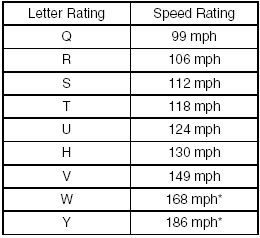
*The letters ZR may be used on tires with a maximum speed capability over 149 mph and will always be used on tires with a maximum speed capability over 186 mph.
J. M+S Marking.
This marking indicates the tire has some mud and snow capabilities and is designed for all-season use.
Tire Size
The following illustration shows an example of a typical passenger car tire size.
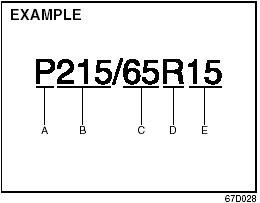
A. Tire Type.
This letter code indicates the primary intended use of the tire. The letter “P” identifies a tire primarily intended for use on a passenger vehicle.
B. Tire Width.
This three-digit number indicates the tire section width in millimeters from sidewall to sidewall.
C. Aspect Ratio.
This two-digit number represents the tire section height divided by the tire section width.
D. Construction Code.
This letter code is used to indicate the type of ply construction in the tire. The letter “R” means radial ply tire construction, the letter “D” means diagonal or bias ply construction, and the letter “B” means belted-bias ply construction.
E. Rim Diameter.
This two-digit number is the wheel or rim diameter in inches.
 WARNING:
WARNING:
Your SUZUKI is equipped with tires
which are all the same type and size.
This is important to ensure proper steering and handling of the vehicle.
Never mix tires of different size or type on the four wheels of your vehicle.
Mixing tires could cause you to lose control while driving which may lead to an accident. The size and type of tires used should be only those approved by SUZUKI Motor Corporation as standard or optional equipment for your vehicle.
Tire Inflation Pressure
Tire inflation pressure should be checked when the tire is cold. “Cold tire inflation pressure” is the pressure in a tire that has been driven less than 1 mile (1.6 km) or has been standing for three hours or more.
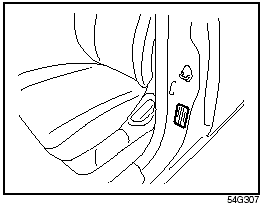
The front, rear and spare tire pressure
specifications for your vehicle are shown
below and are listed on the Tire and Loading
Information Label, which is located on
the driver’s door lock pillar. The Tire and
Loading Information Label contains the following
information:
• Seating Capacity.
• Maximum Allowed Combined Weight of Occupants and Cargo.
• Original Tire Size.
• Recommended Cold Tire Inflation Pressure of Original Tires.
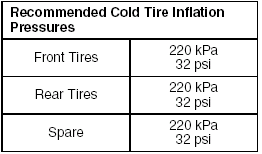
NOTE:
The tire inflation pressure will change due
to changes in atmospheric pressure, temperature
or tire temperature when driving.
To reduce the chance that the low tire pressure warning light will come on due to normal changes in temperature and atmospheric pressure, it is important to check and adjust the tire pressures when the tires are cold. Tires that appear to be at the specified pressure when checked after driving, when the tires are warm, could have pressure below the specification when the tires cool down. Also, tires that are inflated to the specified pressure in a warm garage may have pressure below the specification when the vehicle is driven outside in very cold temperature. If you adjust the tire pressure in a garage that is warmer than the outside temperature, you should add 1 psi to the recommended cold tire inflation pressure for every 10°F difference between garage temperature and outside temperature.
Measuring air pressure
Use the following steps to achieve proper
tire inflation:
1) Identify the recommended tire pressure
on the vehicle’s Tire and Loading Information
Label or in the owner’s manual.
2) Remove the valve cap from the tire valve stem.
3) Using a reliable pressure gauge, measure the tire inflation pressure by pressing the tire gauge firmly onto the valve to get a pressure measurement.
Remember that inflation pressures should be checked when the tires are “cold”, meaning before they have been driven one mile or after sitting for three hours or more allowing the tire to cool to ambient air temperature.
4) If the air pressure is too high, slowly release the air by pressing on the tire valve stem with the edge of the tire gauge until you reach the correct pressure.
5) If the air pressure is too low, fill the tire with air at a service station until it reaches the recommended pressure.
6) Make sure all tires have the same air pressure (unless the owner’s manual indicates otherwise).
 WARNING:
WARNING:
• Air pressures should be checked
when the tires are cold or you may
get inaccurate readings.
• Check the inflation pressure from time to time while inflating the tire gradually, until the specified pressure is obtained.
• Never underinflate or overinflate the tires.
Underinflation can cause unusual handling characteristics or can cause the rim to slip on the tire bead, resulting in an accident or damage to the tire or rim.
Underinflation can also cause tires to overheat, leading to tire failure.
Overinflation can cause the tire to burst, resulting in personal injury.
Overinflation can also cause unusual handling characteristics which may result in an accident.
Tire Inspection
Inspect your vehicle’s tires at least once a month by performing the following checks: 1) Measure the air pressure with a tire gauge. Adjust the pressure if necessary.
Remember to check the spare tire, too. Refer to the “Measuring Air Pressure” section.
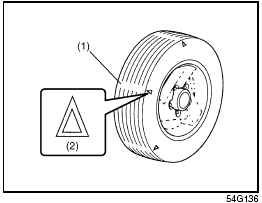
(1) Tread wear indicator
(2) Indicator location mark
2) Check that the depth of the tread groove is more than 1.6 mm (0.06 in.).
To help you check this, the tires have molded-in tread wear indicators in the grooves. When the indicators appear on the tread surface, the remaining depth of the tread is 1.6 mm (0.06 in.) or less and the tire should be replaced.
3) Check for abnormal wear, cracks and damage. Any tires with cracks or other damage should be replaced. If any tires show abnormal wear, have them inspected by your SUZUKI dealer.
 WARNING:
WARNING:
Hitting curbs and running over rocks
can damage tires and affect wheel
alignment. Be sure to have tires and
wheel alignment checked periodically
by your SUZUKI dealer.
4) Check for loose wheel nuts.
5) Check that there are no nails, stones or other objects sticking into the tires.
 WARNING:
WARNING:
Your SUZUKI is equipped with tires
which are all the same type and size.
This is important to ensure proper steering and handling of the vehicle.
Never mix tires of different size or type on the four wheels of your vehicle.
The size and type of tires used should be only those approved by SUZUKI Motor Corporation as standard or optional equipment for your vehicle.
 WARNING:
WARNING:
Replacing the wheels and tires
equipped on your vehicle with certain
combinations of aftermarket wheels
and tires can significantly change the
steering and handling characteristics
of your vehicle. Oversized tires
may also rub against the fender over
bumps, causing vehicle damage or
tire failure. Therefore, use only those
wheel and tire combinations
approved by SUZUKI Motor Corporation
as standard or optional equipment
for your vehicle. For
information regarding the specified
tires, refer to the Tire Information
Label located on the driver’s side
door pillar or the “SPECIFICATIONS”
section.
CAUTION:
Replacing the original tires with tires
of a different size may result in false
speedometer or odometer readings.
Check with your SUZUKI dealer before purchasing replacement tires that differ in size from the original tires.
Uniform Tire Quality Grading
The U.S. National Highway Traffic Safety Administration has developed a grading system for evaluating the performance of passenger car tires. The following information will help you understand the grading system, which applies to vehicles sold in the U.S. Consult your SUZUKI dealer or tire retailer for help in choosing the correct replacement tires for your vehicle.
Quality grades can be found where applicable
on the tire sidewall between tread
shoulder and maximum section width. For
example:
Treadwear 200 Traction AA Temperature A
DOT Quality Grades
Treadwear
Traction AA A B C
Temperature A B C
All Passenger Car Tires Must Conform To Federal Safety Requirements in Addition To These Grades
Treadwear
The treadwear grade is a comparative rating based on the wear rate of the tire when tested under controlled conditions on a specified government test course. For example, a tire graded 150 would wear one and one-half (1 1/2) times as well on the government course as a tire graded 100.
The relative performance of tires depends upon the actual conditions of their use, however and may depart significantly from the norm due to variations in driving habits, service practices and differences in road characteristics and climate.
Traction – AA, A, B, C
The traction grades, from highest to lowest, are AA, A, B and C. Those grades represent the tire’s ability to stop on wet pavement as measured under controlled conditions on specified government test surfaces of asphalt and concrete. A tire marked C may have poor traction performance.
 WARNING:
WARNING:
The traction grade assigned to this
tire is based on straight-ahead braking
traction tests, and does not
include acceleration, cornering,
hydroplaning or peak traction characteristics.
Temperature – A, B, C
The temperature grades are A (the highest), B and C, representing the tire’s resistance to the generation of heat and its ability to dissipate heat when tested under controlled conditions on a specified indoor laboratory test wheel. Sustained high temperature can cause the material of the tire to degenerate and reduce tire life, and excessive temperature can lead to sudden tire failure. The grade C corresponds to a level of performance which all passenger car tires must meet under the Federal Motor Vehicle Safety Standard No. 109.
Grades B and A represent higher levels of performance on the laboratory test wheel than the minimum required by law.
 WARNING:
WARNING:
The temperature grade for this tire is
established for a tire that is properly
inflated and not overloaded. Excessive
speed, underinflation or excessive
loading, either separately or in
combination, can cause heat buildup
and possible tire failure.
Tire Rotation
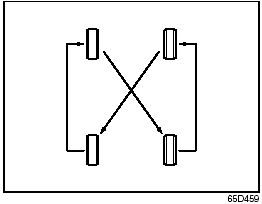
4-tire rotation
To avoid uneven wear of your tires and to prolong their life, rotate the tires as illustrated.
Tires should be rotated as recommended in the periodic maintenance schedule. After rotation, adjust front and rear tire pressures to the specification listed on your vehicle’s Tire and Loading Information Label.
 WARNING:
WARNING:
Rust or dirt on a wheel, or on the
parts to which it is fastened, can
make wheel nuts become loose after
a time. The wheel could come off and
cause an accident. When you change
a wheel, remove any rust or dirt from
places where the wheel attaches to
the vehicle. In an emergency, you can
use a cloth or a paper towel to do
this; but be sure to use a scraper or
wire brush later, if you need to, to get
all the rust or dirt off.
Changing Wheels
To change a wheel, use the following procedure: 1) Remove the jack, tools and spare wheel from the vehicle.
NOTE:
How to remove the spare wheel:
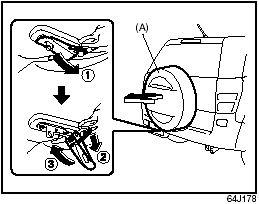
1. (Full cover type).
Release the lock at the underneath of the spare wheel full cover (A) as shown in the illustration, then remove the outer cover of the spare wheel full cover.
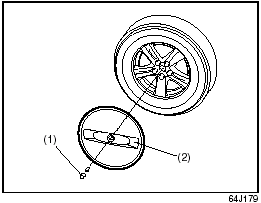
(Half cover type).
Remove the center bolt (1), then remove the outer cover (2) of the spare wheel half cover.
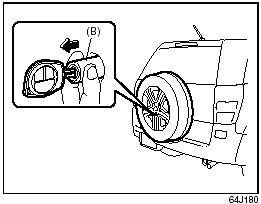
2. Pull out the lock cover (B) fitted on the lock nut of the spare wheel while inserting the key full into the key hole of the lock cover (B).
3. Remove the lock nut and wheel nuts of the spare wheel, then remove the spare wheel with both hands.
2) Loosen, but do not remove the wheel nuts.
3) Jack up the vehicle (follow the jacking instructions in the “EMERGENCY SERVICE” section in this manual).
4) Remove the wheel nuts and wheel.
5) Install the new wheel and replace the wheel nuts with their cone shaped end facing the wheel. Tighten each nut snugly by hand until the wheel is securely seated on the hub.
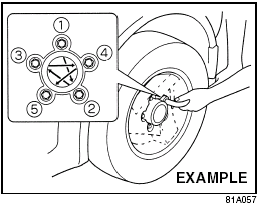
Tightening torque for wheel nut 100 Nm (72.3 lb-ft, 10.0 kg-m)
6) Lower the jack and fully tighten the nuts to the specified torque in a crisscross fashion with a wrench as shown in the illustration.
NOTE:
How to install the spare wheel:
When you install the spare wheel to the
vehicle again, handle it in the reverse order
of removal.
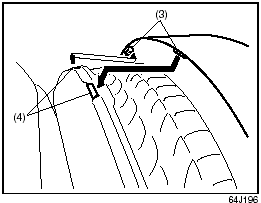
CAUTION:
To avoid the removal of the spare
wheel full cover while driving, be
sure to fit the claws (3) of the outer
cover of the spare wheel full cover to
each hole (4) of the inner cover of the
spare wheel full cover.
 WARNING:
WARNING:
Vehicle equipped with P225/65R17
tires have a spare wheel and tire that
are a different size than the wheels
and tires on the vehicle. The spare
wheel and tire on these vehicles are
intended for temporary emergency
use only. The wheel is painted yellow
to remind you that the wheel and tire
are for temporary use only. Continuous
use of this spare can result in tire
failure and loss of control. Always
observe these precautions when
using this spare:
• Be aware that your vehicle will handle
differently with this temporary
spare.
• Do not exceed 80 km/h (50 mph) speed.
• Replace the temporary spare with a standard tire and wheel as soon as possible.
• Do not operate your vehicle in “4H LOCK” or “4L LOCK” with this temporary spare.
• Do not use tire chains on the spare tire. If you must use tire chains, rearrange the wheels so standard tires and wheels are fitted to the rear axle.
• Replace the spare tire with a new one as soon as the tread wear indicator appears.
• When replacing the spare tire, use a replacement tire with the exact same size and construction.
Snow Tires
Your vehicle is equipped with all-season tires which are designed for use in summer and most winter conditions. For improved traction in severe winter conditions, SUZUKI recommends mounting radial snow tires on all four wheels. Snow tires must be the same size as the standard tires. Also be sure to use the tires of the same type and brand on all four wheels of your vehicle.
GLOSSARY OF TIRE TERMINOLOGY
Accessory Weight – the combined weight (in excess of those standard items which may be replaced) of automatic transmission, power steering, power brakes, power windows, power seats, radio, and heater, to the extent that these items are available as factory-installed equipment (whether installed or not).
Cold Tire Inflation Pressure – the pressure in a tire that has been driven less than 1 mile or has been standing for three hours or more.
Curb Weight – the weight of a motor vehicle with standard equipment including the maximum capacity of fuel, oil, and coolant, and, if so equipped, air conditioning and additional weight optional engine.
Intended Outboard Sidewall – (1) the sidewall that contains a whitewall, bears white lettering or bears manufacturer, brand, and/or model name molding that is higher or deeper than the same molding on the other sidewall of the tire, or (2) the outward facing sidewall of an asymmetrical tire that has a particular side that must always face outward when mounted on a vehicle.
Maximum Inflation Pressure – the maximum cold inflation pressure a tire is designed to support in normal service.
Maximum Loaded Vehicle Weight – the sum of curb weight, accessory weight, vehicle capacity weight (total load capacity), and production options weight.
Normal Occupant Weight – 68 kilograms times the number of occupants specified in the second column of Table 1 (shown below).
Occupant distribution – distribution of occupants in a vehicle as specified in the third column of Table 1 (shown below).
Production Options Weight – the combined weight of those installed regular production options weighing over 2.3 kilograms in excess of those standard items which they replace, not previously considered in curb weight or accessory weight, including heavy duty brakes, ride levelers, roof rack, heavy duty battery, and special trim.
Recommended Inflation Pressure – the cold tire inflation pressure recommended by a manufacturer.
Rim – metal support for a tire or tire and tube assembly upon which the tire beads are seated.
Vehicle Capacity Weight – the rated cargo and luggage load plus 68 kilograms (150 lbs) times the vehicle’s designated seating capacity.
Vehicle Maximum Load on the Tire – the load on an individual tire that is determined by distributing to each axle its share of the maximum loaded vehicle weight and dividing by two.
Vehicle Normal Load on the Tire – the load on an individual tire that is determined by distributing to each axle its share of the curb weight, accessory weight, and normal occupant weight (distributed in accordance with Table 1 shown below) and dividing by 2.
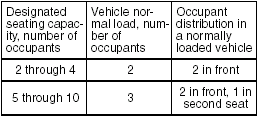
TABLE 1 – Occupant Loading and Distribution For Vehicle Normal Load For
Various Designated Seating Capacities
Vehicle Loading
Your vehicle was designed for specific load capacities. The load capacities of your vehicle are indicated by the Gross Vehicle Weight Rating (GVWR), the Gross Axle Weight Rating (GAWR, front and rear), and the total load capacity, the seating capacity, and the cargo load capacity. The GVWR and GAWR (front and rear) are listed on the Safety Certification Label which is located below the driver’s side door latch striker. The total load capacity and seating capacity are listed on the Tire and Loading Information Label which is located below the Safety Certification Label. The cargo load capacity can be determined as described below.
Cargo Load Capacity – Maximum weight of cargo and luggage that the vehicle can safely carry. Cargo load capacity is the difference between the total load capacity of the vehicle and the total combined weight of all vehicle occupants. Refer to “Steps for Determining Correct Load Limit” for details on how to determine cargo load capacity.
GVWR – Maximum permissible overall weight of the fully loaded vehicle (including all the occupants, accessories and cargo plus the trailer tongue weight if towing a trailer).
GAWR – (Front and Rear) Maximum permissible weight on an individual axle.
Seating Capacity – Maximum number of occupants the vehicle is designed to carry.
NOTE:
Even though the number of occupants is
within the seating capacity, you still must
make sure that you do not exceed the total
load capacity of the vehicle.
Total Load Capacity – Maximum permissible weight a vehicle can carry including the weight of all the occupants, accessories, cargo, plus trailer tongue weight (if towing a trailer).
The weight of any accessories already installed on your vehicle at the time of purchase, or that you or the dealer install after purchase, must be subtracted from the total load capacity to determine how much capacity remains available for occupants, cargo, and trailer tongue weight (if towing a trailer). Contact your dealer for further information.
Actual weight of the loaded vehicle and actual loads at the front and rear axles can only be determined by weighing the vehicle using a vehicle scale. To measure the weight and load, try making your vehicle to a highway weighing station, shipping company or inspection station for trucks, etc.
Compare these weights to the GVWR and GAWR (front and rear) listed on the Safety Certification Label. If the gross vehicle weight or the load on either axle exceeds these ratings, you must remove enough weight to bring the load down to the rated capacity.
 WARNING:
WARNING:
Never overload your vehicle. Overloading
your vehicle can cause damage
to your tires and lead to poor
steering and braking which can result
in an accident. The gross vehicle
weight (sum of the weights of the
loaded vehicle, driver and passengers)
must never exceed the Gross
Vehicle Weight Rating (GVWR) listed
on the Safety Certification Label. In
addition, never distribute a load so
that the weight on either the front or
rear axle exceeds the Gross Axle
Weight Rating (GAWR) listed on the
Safety Certification Label.
 WARNING:
WARNING:
• Always distribute cargo evenly.
• To avoid personal injury or damage to your vehicle, always secure cargo to prevent it from shifting if the vehicle moves suddenly.
• Place heavier objects on the floor and as far forward in the cargo area as possible. Never pile cargo higher than the top of the seatbacks.
Steps for Determining Correct Load Limit
1) Locate the statement “The combined weight of occupants and cargo should never exceed XXX kg or XXX lbs” on your vehicle’s placard.
2) Determine the combined weight of the driver and passengers that will be riding in your vehicle.
3) Subtract the combined weight of the driver and passengers from XXX kg or XXX lbs.
4) The resulting figure equals the available amount of cargo and luggage load capacity. For example, if the “XXX” amount equals 1400 lbs and there will be five 150 lb passengers in your vehicle, the amount of available cargo and luggage load capacity is 650 lbs (1400 – 750 (5 x 150) = 650 lbs).
5) Determine the combined weight of luggage and cargo being loaded on the vehicle. That weight may not safely exceed the available cargo and luggage load capacity calculated in Step 4.
6) If your vehicle will be towing a trailer, load from your trailer will be transferred to your vehicle. Consult this manual to determine how this reduces the available cargo and luggage load capacity of your vehicle.
Vehicle Loading Example
As an example, suppose that the Tire and Loading Information label on your vehicle indicates that your vehicle’s total load capacity is 950 lbs. If you were to drive your vehicle with one passenger, and the total combined weight of you and your passenger was 350 lbs, then the cargo and luggage capacity of your vehicle would be 600 lbs (950 – 350 = 600 lbs).
If you later added 2 more passengers, having a combined weight of 325 lbs, the cargo and luggage capacity of your vehicle would be reduced from 600 lbs to 275 lbs (600 – 325 = 275 lbs). As you can see, as the number and combined weight of vehicle occupants increase, the vehicle’s cargo and luggage capacity decreases.
Suppose again, that you were to take a trip in your vehicle with the same three passengers described above, and you decided to tow a trailer having a trailer tongue weight of 75 lbs. The cargo and luggage capacity would be reduced again, to 200 lbs (275 – 75 = 200 lbs).
Determining Compatibility of Tire and Vehicle Load Limits
The tires on your vehicle, when they are inflated to the recommended tire inflation pressure, have a load-carrying capacity that is greater than the load that will be on the tires when the vehicle is at its GVWR or GAWR limit. Never use replacement tires that have a load-carrying capacity less than the original tires on your vehicle.
Tire load-carrying capacity information is molded into the tire sidewall typically shown as “Max. Load”. Use of replacement tires with a lower load-carrying capacity than the original tires, or failure to keep the tires inflated to recommended tire pressure, may reduce the GVWR or GAWR limit of your vehicle.
NOTE:
Use of replacement tires with a higher
load-carrying capacity than the original
tires, or using a tire inflation pressure
higher than the recommended tire inflation
pressure, will not increase the GVWR or
GAWR limit of your vehicle.
See also:
Spare Tire Nut Lock (if equipped)
Spare Tire Nut Lock (if equipped)
A nut lock is used for the spare tire. To
unlock the spare tire nut, insert the ignition
key into the lock as far as the key will go
and remove the lock with th ...
Other Controls and Equipment
...
Battery
Battery
WARNING:
Batteries produce flammable hydrogen
gas. Keep flames and sparks
away from the battery or an explosion
may occur. Never smoke when working
near the battery.
WARNING ...
